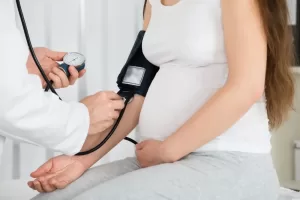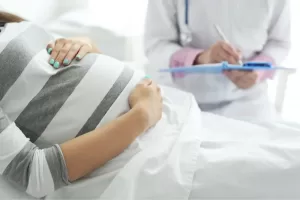Preeclampsia- symptoms, diagnosis & treatment
Medically Reviewed by Dr Davinder Nagah
Last updated on 12.06.2024
What is Preeclampsia?
Preeclampsia is a serious condition that affects around 1 in 10 pregnancies. In Australia, mild Preeclampsia occurs in 5-10% of pregnancies and severe Preeclampsia affects 1-2% of pregnancies . It leads to high blood pressure and raised levels of protein in a pregnant woman’s urine. It tends to start in the second half of pregnancy, though less commonly presents earlier in pregnancy or very shortly after giving birth. Eclampsia is when Preeclampsia becomes more severe, leading to seizures.
What are the symptoms of Preeclampsia?
Preeclampsia can cause a variety of symptoms and complications, though is often silent in the early stages. High blood pressure and/or protein in the urine may be detected on a routine check-up during pregnancy or after the delivery. However, symptoms can also occur, including:
- Headaches
- Nausea and/or vomiting
- Dizziness
- Blurred vision or visual disturbances such as flashing lights
- Discomfort or pain in the upper tummy
- Swelling of the hands, face or feet (swelling can be a normal feature of pregnancy, but in Preeclampsia it tends to develop more suddenly)
As Preeclampsia advances, it can become life-threatening, with complications such as:
- Seizures (also known as “Eclampsia”)
- Problems with the body’s blood clotting system (HELLP Syndrome), which can lead to abnormal bleeding
- Kidney failure
- Liver Failure
- Fluid in the lungs (pulmonary oedema)
What causes Preeclampsia?
It is not fully understood why Preeclampsia happens, though it is thought to begin in the placenta. The placenta is the organ that attaches the developing foetus to the wall of the uterus, and contains the blood vessels that bring oxygen and food to the baby, and remove waste. In Preeclampsia, it seems that these blood vessels do not develop or function as they should. Again, it is not clear why this happens, but genetics may play a role, as well as the immune system or other factors.
Certain women have a higher chance of getting Preeclampsia- risk factors include:
- First pregnancy
- Being over 35 years when pregnant, or early teens
- Pregnancy with multiple foetuses
- Obesity
- History of hypertension (high blood pressure)
- Diabetes
- Kidney disease
When does Preeclampsia start?
It can start any time in the second half of pregnancy, though more typically towards the end of pregnancy. However, much less commonly, it can happen earlier in pregnancy, or shortly after delivery.
Can you get Preeclampsia in more than one pregnancy?
The risk of Preeclampsia happening again in later pregnancies is low. However, the risk is increased in women with chronic medical conditions such as hypertension (high blood pressure), kidney disease, Diabetes, and Lupus. If a woman has had Preeclampsia, she may be prescribed a daily dose of Aspirin in later pregnancies to reduce the risk of getting Preeclampsia again.
Can Preeclampsia harm the foetus?
- Preeclampsia can affect the growth of the foetus, as the placenta may not deliver enough nutrition and oxygen
- Preeclampsia can also lead to placental abruption- this is when the placenta breaks away from the wall of the uterus, meaning the blood supply to the baby is cut off. It requires emergency treatment.
- Severe Preeclampsia can be life-threatening to a pregnant woman, and therefore may also threaten the life of the foetus.
How is Preeclampsia diagnosed?
Preeclampsia may be suspected based on symptoms and/or high blood pressure readings. There may be protein in the urine when a doctor or midwife checks it with a dipstick. Blood tests may show abnormalities in liver function or low platelets. The baby’s health may checked with a foetal monitor and sometimes an ultrasound. As yet, there is no single reliable screening test for Preeclampsia.
What is the treatment for Preeclampsia?
The only cure for Preeclampsia is to deliver the baby and the placenta- sometimes a woman’s labour may be induced early, if necessary.
However, the timing of delivery will depend on several factors such as how advanced the pregnancy is, the health of the mother and the foetus, and how severe the Preeclampsia is.
In milder cases, or if induction of delivery is not ideal, a woman will be monitored closely for symptoms, and her blood pressure and urine will be checked very regularly. Treatment for Preeclampsia may include:
- rest
- admission to hospital for observation
- blood pressure medication
- anti-seizure medication
However, as mentioned above, these treatments do not cure Pre-eclampsia, they just aim to control it- so if the condition of the mother or foetus deteriorates, then delivery may need to be considered
How quickly does Preeclampsia get better after delivery?
In most cases, a woman’s blood pressure is back to normal within about 48 hours. However, blood pressure checks in the following days and weeks are very important, as sometimes blood pressure can become raised again. Other issues such as abnormal liver function or low platelet count tend to take a few weeks to get better.
If you have concerns about Preeclampsia, speak to your doctor or midwife.
Further Patient Resources
Getting a Mental Health Care Plan in Australia: Your Guide
Getting a Mental Health Care Plan in Australia: Your Guide Mental health matters—and if you’re feeling overwhelmed, anxious, or down, a mental health care plan can help. But what is it, and how do [...]
UTI Symptoms and Treatment: What You Need to Know
UTI Symptoms and Treatment: What You Need to Know Urinary Tract Infections (UTIs) are common, uncomfortable, and often disruptive. But what exactly are the signs to watch for, and how can you get relief [...]
Free Mental Health Care Plan Online | Bulk-Billed by Qoctor
Free Mental Health Care Plan Online | Bulk-Billed by Qoctor Discover how to get a free, bulk-billed Mental Health Care Plan (MHCP) in Australia through Qoctor's telehealth service. Accessing [...]






